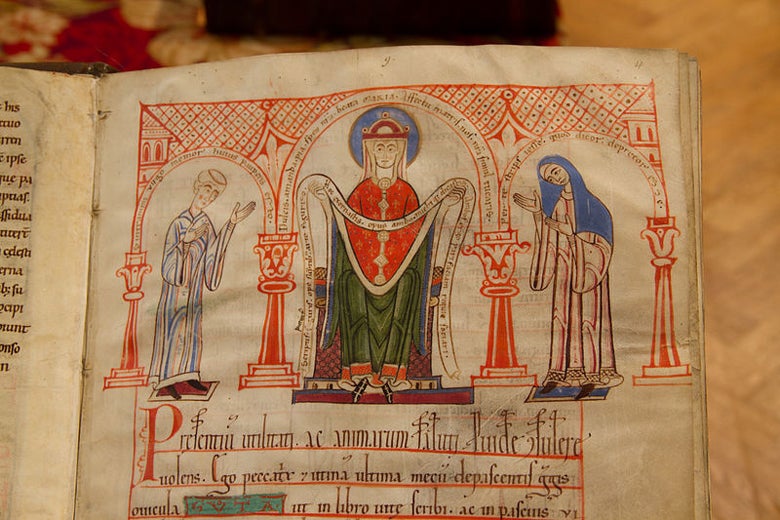
A female scribe and male artist present their book to the Virgin Mary in this medieval manuscript, called the Guta-Sintram Codex (c. 1154). The Codex supports Fiona Griffiths’ finding that men and women collaborated during this period of history. (Image credit: Wikimedia Commons)
The culture of medieval chivalry conjures tales of valiant knights vowing to honor and protect fair damsels. Yet outside the realm of romance, men regarded women as their inferiors – or so we thought.
According to Stanford historian Fiona Griffiths, “We’ve tended to assume that men held power in medieval Europe and that they actively excluded women from any share of it – especially within the church.”
Challenging this claim, Griffiths uncovers how some clergy recognized women’s spiritual power, to which they were often very much attracted.
The collaborative relationships between religious men and women, Griffiths explains, challenge our preconceptions about the Church’s misogyny. “Some priests spent their lives serving women, and developed lasting relationships with nuns, whom they admired as their spiritual superiors – even as conduits to the divine,” she explains.
In her forthcoming book, Nuns’ Priests’ Tales: Gender, Authority, and Apologetics in the Medieval Monastery, c. 400-1200, Griffiths, a professor of medieval Western Europe at Stanford, examines monastic life, theological texts and religious images to reveal “a broader dialogue about women’s spiritual potential.”
Griffiths emphasizes the opportunities, rather than restrictions, that the Church afforded medieval women. In her view, “some male clergy admired religious women, and felt that they could benefit spiritually through service to them, whether through women’s prayers (which some felt were superior to men’s prayers) or through the heavenly rewards that men believed would be given to them as servants of Christ’s ‘brides.'”
Focusing especially on the 11th and 12th centuries, Griffiths traces how the Church reform movement at that time affected relationships between religious men and women. The reform movement required members of the clergy to remain celibate and to restrict their involvement with women, including communities of nuns.
While traditional medieval scholarship has emphasized the presumed segregation of the sexes, Griffiths believes that this tendency has “lost sight of productive relationships” between religious men and women.
Indeed, another effect of Church reform was the dramatic expansion of female monasticism. In other words, many women embraced a religious lifestyle that involved practicing their faith in nunneries.
These cloistered women, Griffiths notes, required a male presence. In the Middle Ages, as in Catholicism today, nuns relied on priests because only male clergy could perform the Communion rite and hear their confessions.
Although traditional medieval texts praise celibate men and saintly women, Griffiths said, “the one figure who seems to have been particularly unworthy of contemporary acclaim is the nun’s priest.”
However, as Griffiths found, “monastic men who took this role as nun’s priest conceived of their position as having spiritual merit, largely by positioning themselves as women’s inferiors, which they did by characterizing nuns as the brides of Christ.”
“I don’t mean to pretend that the medieval world was one of equality,” she said, “but I believe that for religious women in the Church there were certain things that we would think of as being very surprising.”
Spiritual superiors
“When I tell people that I’m working on nuns’ priests, they typically assume that I’m studying scandal,” Griffiths said. The dubious nature of the relationship between nuns and priests typically recalls the Canterbury Tales, which includes a sexually charged story about a cock in a hen house.
Instead, Griffiths’ study showcases the overall harmonious na nature of their relations. “In many cases, priests and nuns lived in very close circumstances.” In fact, certain priests and monks even lived in the women’s monasteries. For Griffiths, this proximity between devoted men and women nourished friendships that were both spiritual and intellectual.
One of the key male figures in Griffiths’ study is Peter Abelard (d. 1142), a French monk and prominent theologian who wrote for and about women more than any other man in the 12th century. As Griffiths observed, “Abelard says very clearly that women’s prayers are more powerful because women are married to Christ.”
Given Abelard’s relationship with Heloise, his former wife-turned-nun, most scholars have doubted the sincerity and the impact of his ideas about women. However Griffiths’ research demonstrates that Abelard was one among several theologians who promoted women’s spirituality, even “addressing women as their spiritual superiors.”
Dignity of women
Moreover, a medieval manuscript recently acquired by Stanford University Libraries gives credence to Griffiths’ claims. Though of later date (c. 1450), the manuscript includes a short text arguing for the dignity of women, echoing ideas that Abelard, too, expressed. Uncovering an increasing amount of documentary support, “it became clear that those ideas had currency in the twelfth century,” Griffiths explained.
One of Griffiths’ key sources is a manuscript known as the Guta-Sintram Codex (c. 1154), which is named after the female scribe and male artist who co-produced it.
In one image, Guta and Sintram present their book to the Virgin Mary. In the text opposite the image, Griffiths identified Abelard’s writings on women’s spirituality. This artifact testifies to an actual collaboration between a man and a woman.
“On one of the pages it looks as though their hands alternate,” Griffiths said. “They were working together in the same room.”
For Griffiths, this manuscript “blows open modern assumptions concerning the separation of the sexes in medieval religious life and men’s resistance to women. It suggests very strongly that there was a valorization of religious figures who engaged with women.
“Looking at what women themselves said and did, it became clear to me that this was not an entirely oppressive, misogynistic period,” she concludes.
Media Contacts
Fiona Griffiths, History: fgriffit@stanford.edu
Corrie Goldman, director of humanities communication: (650) 724-8156, corrieg@stanford.edu